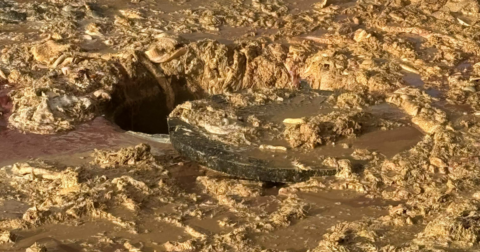Explainer
Agriculture Affects Deforestation Much More Than Most People Realize
Climate•7 min read
“It probably did wonders for your appetite,” one employee wrote to another after the slaughterhouse visit.


Words by Nina B. Elkadi
After receiving a whistleblower’s complaint about conditions at pork producer Seaboard Triumph Foods LLC in Sioux City, Iowa, the state Department of Natural Resources (DNR) decided a visit to the facility was in order. On an “empty stomach would probably be best,” Amber Wolf, a DNR Senior Environmental Specialist, wrote to her colleague.
According to documents reviewed by Sentient produced through a records request, DNR employees who visited the plant were shaken by conditions at the facility.
“I’m still recovering from my STF visit yesterday,” Wolf wrote to her colleague, John Curtin, who works in the DNR Air Quality Bureau.
As Sentient previously reported, former Seaboard Triumph Foods employee Steven Barrows tipped off the Environmental Protection Agency (EPA) regarding unsanitary and hazardous conditions at the facility, sharing photos of stacks of dead pigs and waste pooling on floors. Seaboard Triumph Foods has repeatedly violated air quality monitoring regulations since 2018 and also faced labor violations through a third party contractor.
In emails reviewed by Sentient about the April whistleblower complaint, DNR employees discussed high volumes of wastewater generated by the facility, the pileup of dead pigs and hazardous emissions from the biogas produced by its waste. The Iowa DNR commented that “there is currently an ongoing enforcement action” and “the department is most concerned about the sulfur dioxide emissions, a criteria air pollutant.” The EPA told Sentient that the DNR is leading in this matter and acknowledged receipt of the April complaint. Seaboard Triumph Foods did not respond to a request for comment about the statements made in these emails.
Seaboard Triumph Foods sends their wastewater to the city of Sioux City. After her visit, Wolf wrote to Curtin, “A lot of their wastewater does go to the city, 2.2 million gallons a day!” In an internal DNR email reviewed by Sentient, EPA employee Jodi Bruno confirmed that Seaboard Triumph Foods only has an air permit, and does not “appear to have a direct discharge NPDES permit,” which is a permit under the National Pollutant Discharge Elimination System (NPDES) that allows a facility to discharge wastewater to a public body of water. DNR confirmed to Sentient that “The facility drains into the sanitary sewer, so there is no requirement for an NPDES permit.” EPA wrote to Sentient that the corporation “has a Pretreatment Agreement with the city that governs their discharge to the treatment plant.”
Wolf’s emails reference messy scenes, likely referring to the conditions that whistleblower Barrows witnessed and reported to the EPA. “There weren’t glaring violations and the ‘mess’ was recently cleaned up,” she wrote. In response to Wolf’s debrief, Curtin wrote: “Thank you for going out and checking on this. It probably did wonders for your appetite. I am glad the ‘mess’ was cleaned up.”
After Wolf’s visit, an email from Mark Johnson, Deputy District Manager at the U.S. Department of Agriculture (USDA)’s Food Safety and Inspection Service, explained that the dead-pig pileup was due to an equipment breakage: one of the two “cookers” used to process rendered pigs broke down, which led to an “accumulation of product to be rendered.” In his email to a USDA employee, an Iowa Department of Agriculture employee and a Department of Natural Resources employee, he noted that STF’s “newly installed cooker should be able to keep up with their demands,” and that they plan to replace the other, older cooker with a larger one in November 2025.
Emails obtained by Sentient also suggest that the slaughterhouse is not flaring much biogas. Flaring is a method of burning off excess methane-rich biogas that the plant does not need to use for energy. This could be a positive, if most biogas is being captured and used for energy, or it could signal low production, equipment issues or unburned methane leaks. These emails suggest the latter.
After her visit, Wolf wrote that there is “still little biogas being produced,” which suggests that the lagoons may not be properly “digesting” the animal waste.
Curtin wrote to Wolf, “Are they diverting the organic waste from the lagoon and sending it directly to the city? Is the water too cold for the bugs? Bad design? We never got an explanation from them on why the lagoons have not worked properly.” In addition to water temperature, pH and the concentration of organic matter in the lagoon can also affect how well the “bugs” — that is, microbes — can digest waste into methane, he wrote.
Decomposing slaughterhouse and rendering waste can produce high concentrations of the toxic gas hydrogen sulfide. In biogas, hydrogen sulfide is considered an “impurity,” and is typically flared off and converted into sulfur dioxide in the process of anaerobic digestion. Biogas at Seaboard Triumph Foods contained between 10,764 to 16,265 parts per million hydrogen sulfide during the spring and summer of 2025, far above the permitted level of 4,000 parts per million, internal records show. To properly control these high levels of hydrogen sulfide, they would need to convert it to sulfur dioxide, presumably resulting in high sulfur dioxide emissions. In 2025, Seaboard Triumph Foods was fined $7,000 for approximately 2,000 hours of air quality violations. Sulfur dioxide can cause serious respiratory issues to anyone exposed.
According to one June 2025 email, Seaboard Triumph Foods has a continuous hydrogen sulfide monitor “but have not used it yet.”
On May 9, 2025, in response to Seaboard Triumph’s April hydrogen sulfide reading of 10,764 parts per million, Curtin wrote to Wolf that the corporation proposed increasing their hydrogen sulfide limits to 8,200 parts per million.
“I don’t quite know how they are going to meet that limit either…have a nice weekend!” Wolf replied.
In response to Sentient’s reporting detailing the whistleblower’s original complaint, one DNR environmental engineer wrote in an internal email: “Wow. That’s a lot worse than I had pictured in my head. I never need to go there again.”